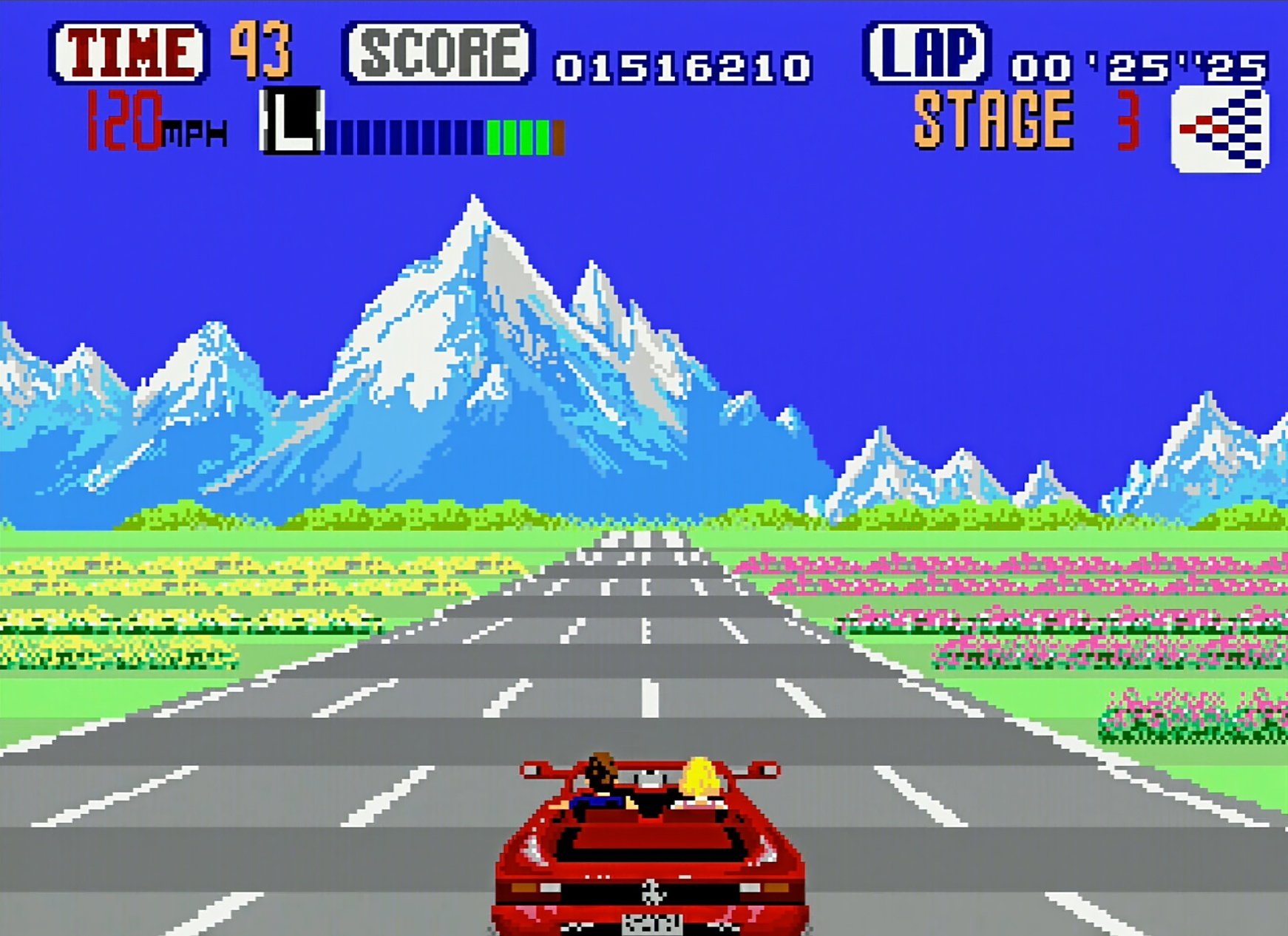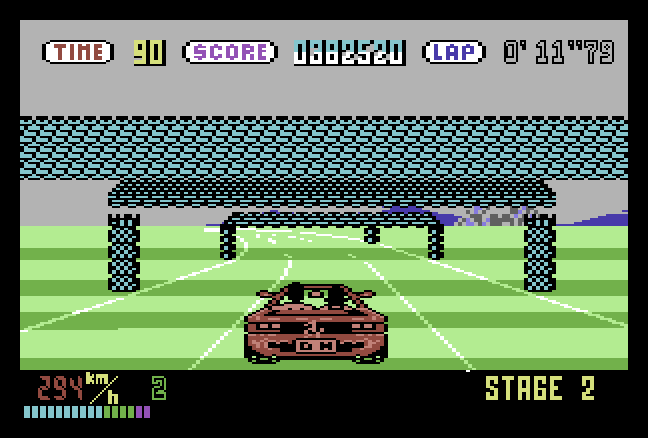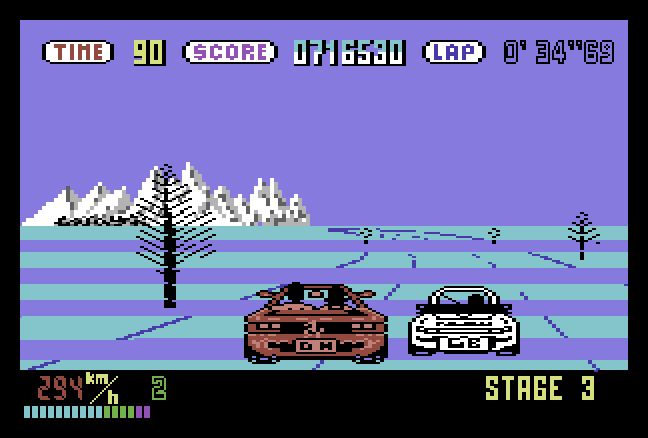
6 o'clock, November cold morning of 1987. 17-year-old programmer Martin Webb is sitting in front of a computer in a house in Shropshire. Martin's father, Dennis Webb, is also here, as is Jeff Brown, the head of the game publishing company US Gold. They did not sleep all night.
Last night, just minutes before the start of tens of thousands of copies of the OutRun version of the Commodore 64 game at Ablex Audio Video Studios in Telford, which were supposed to hit the alluring Christmas market, one of the testers reported a problem during the mastering process. Somewhere between Martin’s code and the US Gold turbo tape loader, a bug was hiding. They were unable to resolve the error in the factory, so they moved to a house nearby so that Martin could concentrate on the problem in silence. No one said a word, but the teenager did not need to be reminded of what was at stake. OutRun was the most popular arcade game, and US Gold paid Sega upfront £ 250,000 to get distribution rights for the game for home computers (the most expensive licenses usually sold for a quarter of that amount). Contracts were signed, and advertising spun for several months. Probably, at that time it was the most anticipated project of transferring the game from arcade machines, and Martin was responsible for creating the most important version for C64, which will be sold worldwide.
Adults left the room to make breakfast, leaving Martin alone. By that time, he barely held back tears. “I was exhausted because I did not sleep for several days,” he says, recalling that morning in the house. “I could easily lose my balance and give up. But at such moments, you realize that giving up is much worse than fighting. Going forward, no matter how hard it may seem, is easier than losing everything you donated. I felt it even at 17 years old. "
Most readers should remember OutRun, the laid-back Sega arcade racing game that appeared on arcade machines in 1986. The player drove a Ferrari Testarossa along long freeways, trying to keep fit at the right time and impress the blonde in the passenger seat. However, the path of Martin, who received the task of converting OutRun, was a little different. He and his father Dennis plunged into the family-owned Ford Sierra and headed north on the M1, from their home in Kent to the US Gold Birmingham office. “I was always annoyed with trips with my father,” says Martin. “I loved listening to the radio, and my father loved talking. We left early, and I just wanted to. to sleep and dream. But my father longed to talk about games and my code. It exhausted me. "

Dennis was responsible for the graphics, so he wrote his initials and the initials of Martin on gaming cars.
Although Martin was only 17 years old, he had already become an experienced programmer who had released over ten games. Most of these games were original projects for the Texas Instruments TI-99 / 4A home computer, which were mostly sold by mail. My father ran a business (and therefore Martin), and also created graphics for games. Their company, Intrigue Software, started well and earned a decent reputation among TI-99 users.
“It was a good source of money,” Martin says. “I have gained experience in developing games for the TI-99, so the business went well and my dad was pleased. When I finished the game, orders immediately appeared on it. " But the TI-99 market was tiny, and it narrowed even more when C64, Spectrum and other systems began to dominate. “We did not make money. My father dragged me to the bank, told the manager that I was a child prodigy, and the manager increased our overdraft. That was how simple it was. My father just said that I was making a new game, reported the sales figures, and they gave us money. ”
Debts were growing, and Martin began to look for ways to solve the problem. Obviously, it was necessary to abandon the TI-99 and begin development for more popular systems. He chose C64 and spent about a year learning programming for 6502, and then used his new skills to create a simple fighting game called Karate Chop. The next problem was the way the game was sold. “The C64 and Spectrum markets were developing, and by then several major players had appeared on them. If you created the game, then thousands of pounds were required for full-color advertising, and we were aground, and therefore could not compete. We needed to sell the game for C64 to one of the publishers, get an advance, and leave the worries about the company's sales. So, after five years of selling our own games by mail and several bankruptcies, I began to beg my father to take me to one of these large software companies. ”

The famous Gateway level released on the C64. The graphics were simple and square, but fast.
Martin says convincing his father to change tactics was not easy. “Before, my father came up with ideas for games and did business in a free room, while I sat in my bedroom. He also controlled the 17-year-old me, so that game development would be completed on time. I am an absolute perfectionist, so I can imagine how difficult it was. In addition, teenagers and parents are not the best combination, and we had quite a lot of personal frictions, which usually ended up running away into the countryside, and my father went and searched for me. Today I smile, but then everything was very serious. The debate began with words, but soon turned into almost fights, and later it got worse. ”
Financial problems and tension in the house increased, so Dennis agreed with Martin's proposal. They took Karate Chop to Ocean Software, but this Manchester-based company was already developing a home version of Yie Ar Kung-Fu from arcade machines, so they refused to publish it. However, another publisher, Melbourne House, laid out for her 5,000 pounds. Inspired by Martin, he developed Max Torque, a clone of the Sega motorcycle racing game Hang-On, which he successfully sold to Bubble Bus Software. He then began work on the OutRun clone. “I already wrote the road code for Max Torque - turns and the like. It was pretty easy to replace a motorcycle with a car - and boom! “You have another game!” To avoid legal problems, instead of a Ferrari, he used a Porsche-style car. “I asked my father to take me to the Porsche garage in Maidstone. We photographed the rear of the 911 from different angles, and then circled the photos to create a sprite sheet. I remember we even argued. Dad said, “I can just draw a car.”
The day Webb went to US Gold, they brought with them a demo of their OutRun clone for the C64, not knowing that the firm had just officially licensed the Sega game from the machines.
“When we finally got there, the father seemed to be impressed: he probably thought that was our big chance. US Gold was based in a huge glass building, and the parking lot was full of expensive cars. We met with CEO Jeff Brown and I showed him a demo of my car race. We were in the office, where there were three or four more programmers, and he invited them to see what I did. In my game, Porsche rode a road taken from a Hang-On clone; I added a dashboard with a steering wheel, speedometer and gearbox. I did this because in the OutRun arcade machine, the players were sitting in a chair, and I wanted to convey this feeling. When I downloaded the game and showed my Porsche, very similar to the ones that stood next to the office, I attracted the attention of everyone in the office. I didn’t know this yet, but they realized that Jeff’s bid on a contract with Sega had justified itself. ”

Porsche from OutRun clone appeared in the official version.
It turned out that the 17-year-old guy had created a prototype of exactly what US Gold needed - and that was during Easter, that is, there were still several months left to complete the game by Christmas 1987. “Jeff called me into the adjoining room where the OutRun was standing. He asked: “Martin, can you do this? Can you turn this game into a version for C64? ”I was shocked. In an hour, the lawyers and my father drew up a contract, and so I started my first conversion of the game. In advance, we were paid about 20 thousand pounds. For 1987, it was a ton of money. ”
Despite the fact that the OutRun arcade machine was a technical monster running two 68000 processors, Martin felt that he could do it and create a decent version that could work on the weak 6510 Commodore 64 processor. “Yes, the stakes were high,” he said, having in mind a substantial advance. “It turns out that my father put our house on the line and we had a deadline, but the game with Porsche was already working, so I had the advantage. I remember that the first thing I did was create a splash screen, a radio screen for selecting a soundtrack and a highscore screen. I wrote them because these elements were needed by US Gold, and having created them, I knew how much memory I still had. After this, there were only two real problems for the game: hills and a huge amount of graphics. ”
He dealt with the hills in a couple of hours (“It was enough to learn how to shift the horizon created in the desired raster line up and down”), but there were difficulties with the graphics: what to choose - speed or detail of the image? “For me, speed was a real test of skill,” he says. “OutRun was fast on arcade machines, so I knew that it should remain fast on home computers. But I also understood that it would be necessary to pay for it with square sprites of objects instead of the original graphics. It was risky, but I decided it was better to choose large, fast-moving objects than small and smoother ones. It was a matter of personal taste. If I were remodeling the game today, perhaps I would go the other way, but when I tested the game, I was proud of the objects flying instantly across the screen. ”
Everything was going well and Martin was several weeks ahead of schedule, but the finish line suddenly moved further. “Initially, US Gold asked to create only a few tracks. But when I finished in October, Jeff asked me to port all the tracks, which was a titanic task. We didn’t have the design documents of the original, only the arcade game itself, so I had to master each track and record the passage on video with Super 8. I played a lot of this game. ”
Additional content stretched the development process almost to the deadline and led to a bug that almost prevented duplication of the game. Martin managed to eliminate it at the last moment, but he could not do anything with the multiple-boot procedure, because of which it was impossible to realize the fork in the roads that the original game was famous for. The absence of this feature was mentioned in most magazine reviews, including in Zzap! 64: the publication praised the game for its “amazing speed”, but complained about the lack of “playability and zest”, giving it a rating of 68%. This rating was pretty standard, and if Metacritic existed at that time, then this version of the game would get an average rating of 58.

Martin Webb programmed the OutRun version for C64 when he was only 17 years old.
But for those involved in the development of the game, sales were the only significant indicator, and OutRun did not disappoint here. The game was released on December 10, but it still managed to become a 1987 bestseller. US Gold said that over the Christmas days, sales of all game formats have surpassed 250,000 copies. Webb got a decent reward, and for them the times have ended when they had to come for handouts to the bank. “We were reimbursed the advance payment and the first royalties for January sales amounted to 17 thousand pounds,” says Martin. “The months that followed were also very good. Father received royalties until the 90s, because OutRun was sold again and again in collections, each of which became a bestseller. I do not know the exact amount, but I think that there was a lot of money - perhaps 70-80 thousand. When we received the first check with royalties, I exchanged my Mini Cooper for a Ford Fiesta XR2. And a few months later he changed it to Ford Orion 1.6i Ghia. "
That is, there were no Ferrari? "There was no Ferrari, but Orion is a pretty cool car for the 18 year old."
For Martin, nothing was impossible. He flew to Chicago to work on the "improved" NTSC version of OutRun, published by Mindscape. “When I was there, I was invited to dinner with the Nintendo boss. I think today it’s called “headhunting”, but then I was young and did not know this, and my father cherished his asset too much - me. ” After the Webbs returned to the UK, US Gold invited them to work on porting another arcade game - Atari's RoadBlasters. Martin was able to reuse the track editor developed for OutRun, so it was quick, easy and profitable.
However, successes did not smooth out the contradictions between father and son. “At home, my father often fell for me, but when we visited computer fairs, he greatly praised me. He informed the visitors to our games that I made them. He seemed very proud of me, but when at home I could not cope with the work, everything was completely different. Later, I found out that many close friends of the family tried to appease my father, doubting that the pressure and burden benefit the teenager. But if you knew my father, you would understand that it was a waste of time. ”

RoadBlasters Port for Commodore 64
This was followed by several small game projects, but Martin decided to move on and leave home and the gaming industry. “When I finished developing games, it caused a lot of problems, and I don’t really like talking about this stage of my life,” he says, explaining his reluctance to discuss the next years and whether they found a common language with his father.
“Now I live in Brazil with my mother, who had to endure all the dramas and quarrels of the gaming years of our lives. Even 30 years later, the scars did not heal. I was young, and my father put too much pressure on me. I do not regret it, in a way I respect him for having trusted so much in me. It was probably hard. I would like to continue to create games and, possibly, do something more in this industry. For me, the symbol of the 80s is music, powerful hatchbacks and video games. The video game industry was in its infancy. Just children and youth creating projects in their bedroom. It was an amazing time. ”
Warm June evening of 2017. Martin's son Thomas is auditioning for America's Got Talent under the stage name Tom London. When the 25-year-old “technical magician” meets with the judges before the performance, Simon Cowell asks him: “Who was your role model?”
“My father,” Thomas says. “All my life I dreamed of being like him. If not for him, I would not have been able to achieve and do what I am doing now. ”